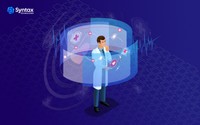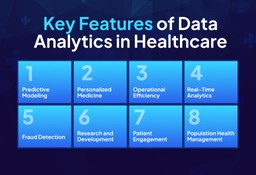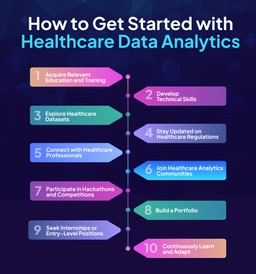Hey, Future Data Rockstars!
Ever wondered how superheroes in lab coats use their magical numbers to save lives?
Get ready to unlock the secret lair of healthcare’s unsung heroes – Data Analysts!
Imagine a world where every heartbeat, every sneeze, and every hiccup is transformed into a series of information, guiding healthcare professionals to make decisions that can literally be a matter of life and death.
This is where data meets stethoscopes, and algorithms play superhero sidekicks to doctors!
If you’re considering starting a healthcare analytics career, knowing the basics through a data analytics course can propel you quicker than ever!
So, buckle up because we’re about to embark on a journey that turns raw data into medical miracles.
How Technology Has Changed the Healthcare Field
Imagine a time when waiting rooms and paperwork were the norm. Well, wave goodbye to that era as technology strides in, offering us the gift of telemedicine.
Thanks to this digital magic, people can now connect with their healthcare providers from their living rooms.
Say farewell to the old-fashioned waiting area woes and hello to virtual check-ups in pajamas!
And let’s not forget our robotic companions in the operating room. Surgical precision has taken on a whole new meaning with the help of robots.
These mechanical marvels, guided by skilled surgeons, perform intricate procedures with the finesse of a maestro wielding a baton.
But wait, the tech extravaganza doesn’t end there! Behind the scenes, in the digital command center of this healthcare revolution, lies the unsung hero – data analytics.
Picture this: mountains of health data, like pieces of a giant puzzle, being sifted through by algorithms and data wizards. This is where the magic truly happens.
Data analytics has become the Sherlock Holmes of healthcare, uncovering patterns, solving mysteries, and predicting potential health issues before they enter.
Your electronic health records, once just a digital version of a paper trail, are now a treasure trove of insights.
Data analytics sifts through this wealth of information, providing healthcare professionals a roadmap to personalized and effective treatments.
Have you ever wondered how your fitness tracker knows you’ve had too many lazy days?
Data analytics is the wizard behind the curtain, analyzing your daily steps, heart rate fluctuations, and sleep patterns to create a personalized health profile.
Becoming a healthcare data analyst is an excellent option if you want to specialize. Keep reading to learn precisely what you must do to start your newfound data career!
Key Features of Data Analytics in Healthcare
Alright, now let’s unravel the power-packed features that make data analytics the superhero of the healthcare realm.
Predictive Modeling:
Ever wished healthcare could foresee the future? Well, with predictive modeling, it’s closer than you think. Data analytics sifts through mountains of historical data to predict potential health issues, allowing proactive interventions and personalized treatment plans.
Personalized Medicine:
Say goodbye to one-size-fits-all treatments. Data analytics crafts a unique health profile for individuals, considering genetics, lifestyle, and medical history. This tailored approach ensures that treatments are as unique as our fingerprints.
Operational Efficiency:
In the bustling world of healthcare, time is of the essence. Data analytics optimizes hospital workflows, streamlining processes from appointment scheduling to resource allocation. It’s like a digital maestro orchestrating the symphony of healthcare operations.
Real-Time Analytics:
In emergencies, every second counts. Real-time analytics empowers healthcare professionals to make informed decisions on the spot. Whether it’s monitoring vital signs or assessing the effectiveness of a treatment, real-time data is the superhero cape in critical situations.
Fraud Detection:
Data analytics safeguards healthcare systems from fraud. By detecting unusual patterns and anomalies in billing and claims data, it ensures that resources are directed where they’re truly needed.
Research and Development:
The quest for medical breakthroughs is relentless. Data analytics transforms raw research data into meaningful insights, accelerating the pace of discovery and innovation. It’s the compass guiding researchers through the maze of possibilities.
Patient Engagement:
In the era of empowered patients, data analytics takes center stage. It enables healthcare providers to engage with patients on a personal level, offering insights into their health journey, encouraging preventive care, and fostering a collaborative approach to well-being.
Population Health Management:
Think of it as healthcare on a grand scale. Data analytics assesses the health of entire populations, identifying trends and risk factors. This bird’s-eye view allows for the development of targeted public health initiatives and policies.
So, there you have it – the key features that make data analytics the unsung hero in the healthcare saga.
Top Data Analytics Tools Used in Healthcare
Ready to explore the digital toolbox that’s transforming healthcare through the lens of data analytics?
Here are the top data analytics tools that have taken center stage in the healthcare revolution:
SAS Analytics:
The heavyweight champion in data analytics, SAS Analytics is a versatile tool that flexes its muscles in healthcare.
From predictive modeling to statistical analysis, it empowers healthcare professionals with robust insights, making it a go-to choice for organizations aiming for data-driven precision.
IBM Watson Health:
Imagine having an AI-powered genius in your corner. That’s IBM Watson Health for you.
This cognitive computing platform dives into vast datasets, extracting valuable information to support clinical decisions, drug discovery, and even genomics research. It’s like having a digital healthcare advisor at your fingertips.
Tableau:
When it comes to turning data into visual masterpieces, Tableau steals the spotlight. Healthcare professionals use it to create interactive and intuitive dashboards, making complex medical data accessible and understandable.
Microsoft Power BI:
Microsoft Power BI is the superhero cape for healthcare organizations seeking real-time analytics.
With its user-friendly interface and reporting capabilities, it enables quick decision-making, operational optimization, and a data-driven approach to improving patient outcomes.
RapidMiner:
RapidMiner is the Swiss Army knife of data analytics, and healthcare organizations are leveraging its capabilities for predictive analytics, machine learning, and data preparation.
It’s the tool that dives deep into data lakes, extracting nuggets of actionable insights for smarter healthcare strategies.
Google Cloud Healthcare API:
In the era of cloud computing, Google Cloud Healthcare API emerges as a key player. It facilitates the secure exchange of healthcare data, promoting interoperability and collaboration among different healthcare systems. Think of it as the bridge connecting the islands of medical information.
KNIME:
KNIME (Konstanz Information Miner) is the open-source champion in data analytics. Healthcare researchers and data scientists appreciate its flexibility and extensibility for building and deploying data workflows.
It’s the open road for those navigating the twists and turns of healthcare data exploration.
Alteryx:
Alteryx is the speedster in data blending and advanced analytics. Healthcare analysts use it to seamlessly prepare, blend, and analyze data from various sources, accelerating the journey from raw data to actionable insights. It’s the Formula 1 car on the data racetrack.
So there you have it – the elite squad of data analytics tools reshaping the healthcare landscape.
Is College
Worth It Anymore?
How to Get Started with Healthcare Data Analytics
Embarking on the exciting journey of healthcare data analytics?
Fantastic choice!
Here’s your roadmap to dive into the world where data meets health, and insights lead to better patient outcomes.
Step 1: Understand the Basics of Healthcare and Data Analytics:
Familiarize yourself with healthcare processes, terminology, and the unique challenges faced by the industry. Simultaneously, grasp the fundamentals of data analytics, including statistical analysis, machine learning, and data visualization.
Step 2: Acquire Relevant Education and Training:
Invest time in formal education or online courses specific to healthcare data analytics. Platforms like Coursera, edX, and LinkedIn Learning offer courses ranging from basic introductions to advanced analytics techniques.
Step 3: Develop Technical Skills:
Get hands-on experience with the tools commonly used in healthcare data analytics, such as SAS Analytics, IBM Watson Health, Tableau, or Microsoft Power BI. Learn programming languages like R or Python and explore databases and data manipulation techniques.
Step 4: Explore Healthcare Datasets:
Dive into publicly available healthcare datasets to practice your skills. Websites like the Centers for Disease Control and Prevention (CDC) or the World Health Organization (WHO) provide datasets for analysis. This hands-on approach will help you apply your knowledge to real-world scenarios.
Step 5: Stay Updated on Healthcare Regulations:
Understand the regulatory landscape of healthcare, including HIPAA (Health Insurance Portability and Accountability Act) compliance. Knowing the legal and ethical considerations surrounding healthcare data is crucial for responsible and secure data analytics.
Step 6: Connect with Healthcare Professionals:
Build relationships with healthcare professionals to gain insights into the industry’s challenges and needs. Collaborating with experts will not only enhance your understanding but also guide you in developing analytics solutions that are practical and impactful.
Step 7: Join Healthcare Analytics Communities:
Engage with some online communities and forums dedicated to healthcare analytics. Platforms like Kaggle, where data scientists collaborate on real-world projects, can provide valuable learning opportunities and exposure to diverse challenges in healthcare analytics.
Step 8: Participate in Hackathons and Competitions:
Test your skills by participating in healthcare data analytics competitions. These events challenge you to solve specific problems and provide a platform to showcase your abilities.
Step 9: Build a Portfolio:
Assemble a portfolio showcasing your projects, analyses, and solutions. Highlight your ability to derive meaningful insights from healthcare data and communicate your findings effectively. A strong portfolio is invaluable when seeking opportunities in the field.
Step 10: Seek Internships or Entry-Level Positions:
Apply for internships or entry-level positions in healthcare organizations or data analytics firms. Practical experience in a healthcare setting will deepen your understanding and provide a platform to apply your skills in a real-world context.
Step 11: Continuously Learn and Adapt:
Healthcare and data analytics are dynamic fields. Stay curious, keep learning, and adapt to new technologies and methodologies. Attend conferences, webinars, and workshops to stay abreast of the latest developments in healthcare data analytics.
By following these steps, you’ll be well on your way to becoming a healthcare data analytics maestro.
So, gear up, embrace the data-driven adventure, and let your insights contribute to a healthier and more efficient future in healthcare!
Career Transition Toolkit
Navigating the Data-Driven Horizon with Syntax Technologies
Your journey into healthcare data analytics promises an exciting blend of technological prowess and healthcare expertise.
Armed with the right skills, tools, and insights, you’re poised to impact the evolving landscape of patient care significantly.
As you navigate this dynamic field, consider enlisting the support of Syntax Technologies. Our comprehensive data analytics course is designed to empower aspiring professionals like you. With a blend of theoretical knowledge and hands-on practical experience,
So, whether you’re a seasoned data enthusiast or a newcomer to data analytics, let Syntax Technologies be your guide.




